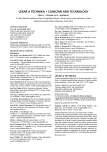-
Články
- Časopisy
- Kurzy
- Témy
- Kongresy
- Videa
- Podcasty
VENTILATOR CIRCUIT MODEL FOR OPTIMIZATION OF HIGH-FREQUENCY OSCILLATORY VENTILATION
Ventilators for high-frequency oscillatory ventilation (HFOV), Sensormedics 3100, were not designed to tolerate spontaneous breathing of a patient. An experimental Demand Flow System (DFS) is being developed to support spontaneous breathing during HFOV. A control system of the DFS requires a model of the ventilator circuit of Sensormedics 3100. A new model of the circuit was designed, including the oscillating membrane, the inspiratory and expiratory branches of the circuit, the expiratory valve, and a spontaneously breathing patient. The model was implemented in the Multisim software environment. A bench test suggests that the model predicts the basic changes in pressure within the ventilator circuit and that its modified version can be used in the DFS control algorithm.
Keywords:
high-frequency oscillatory ventilation (HFOV), ventilator circuit, lumped-parameter model, electro-acoustic analogy
Autoři: Jan Matějka; Jakub Ráfl; Michal Čech; Martin Rožánek
Působiště autorů: Czech Technical University in Prague, Faculty of Biomedical Engineering, Kladno, Czech Republic
Vyšlo v časopise: Lékař a technika - Clinician and Technology No. 2, 2012, 42, 61-64
Kategorie: Conference YBERC 2012
Souhrn
Ventilators for high-frequency oscillatory ventilation (HFOV), Sensormedics 3100, were not designed to tolerate spontaneous breathing of a patient. An experimental Demand Flow System (DFS) is being developed to support spontaneous breathing during HFOV. A control system of the DFS requires a model of the ventilator circuit of Sensormedics 3100. A new model of the circuit was designed, including the oscillating membrane, the inspiratory and expiratory branches of the circuit, the expiratory valve, and a spontaneously breathing patient. The model was implemented in the Multisim software environment. A bench test suggests that the model predicts the basic changes in pressure within the ventilator circuit and that its modified version can be used in the DFS control algorithm.
Keywords:
high-frequency oscillatory ventilation (HFOV), ventilator circuit, lumped-parameter model, electro-acoustic analogy
Zdroje
[1] Roubík, K., Ráfl, J., van Heerde, M., Markhorst, D. G. Design and control of a demand flow system assuring spontaneous breathing of a patient connected to an HFO ventilator. IEEE Trans Biomed Eng, 2011, vol. 58, no. 11, p. 3225–3233.
[2] van Heerde, M., et al. Unloading work of breathing during high-frequency oscillatory ventilation: A bench study. Critical Care, 2006, vol. 10, no. 4, p. R103.
[3] Škvor, Z. Vibrating systems and their equivalent circuits. 2nd ed. Prague: Academia, 1991.
[4] Bates, J. H. T. Lung mechanics: An inverse modeling approach. 1st ed. New York: Cambridge University Press, 2009.
[5] Matějka, J. Model pacientského okruhu pro optimalizaci vysokofrekvenční oscilační ventilace. [Bachelor thesis]. Prague: CTU FBMI, 2012.
[6] Čech, M. Modelování a měření základních komponent v respirační péči. [Bachelor thesis]. Prague: CTU FBMI, 2012.
[7] van Genderingen, H. R., et al. Reduction of oscillatory pressure along the endotracheal tube is indicative for maximal respiratory compliance during high-frequency oscillatory ventilation: A mathematical model study. Pediatric Pulmonology, 2001, vol. 31, no. 6, p. 458–463.
[8] Schranz, C., Moeller, K. Inverse modeling supports quantification of pressure and time depending effects in ARDS patients. In: 33rd Annual International Conference of the IEEE EMBS, Boston, Aug 30–Sep 3, 2011, p. 1013–1016.
[9] Schranz, C., Moeller, K. Model-based quantification of pressure and time depending effects in ARDS patients. In: 5th International Conference on Bioinformatics and Biomedical Engineering (iCBBE), Wuhan, May 10–12, 2011, p. 1–4.
[10] Pino, A. V., Giannella-Neto, A. A new method to obtain a positive end-expiratory pressure. In: Proceedings of the 18th Annual International Conference of the IEEE EMBS, Amsterdam, Oct 31–Nov 3, 1996, p. 1689–1690.
Štítky
Biomedicína
Článok vyšiel v časopiseLékař a technika

2012 Číslo 2-
Všetky články tohto čísla
- EYE TRACKING PRINCIPLES AND I4TRACKING® DEVICE
- MODELING OF CIRCULATION DYNAMICS WITH ACAUSAL MODELING TOOLS
- Methodology of thermographic atlas of the human body
- INDUCTION SENSORS FOR MEASUREMENT OF VIBRATION PARAMETERS OF ULTRASONIC SURGICAL WAVEGUIDES
- Linear Modelling of Cardiovascular Parameter Dynamics during Stress-Test in Horses
- MONITORING OF BREATHING BY BIOACOUSTIC METHOD
- Editorial
- APPLICATION OF TIME DOMAIN REFLECTOMETRY FOR CHARACTERIZATION OF HUMAN SKIN
- REAL-TIME PROCESSING OF MULTICHANNEL ECG SIGNALS USING GRAPHIC PROCESSING UNITS
- MATLAB AND ITS USE FOR PROCESSING OF THERMOGRAMS
- IDENTIFICATION OF MAGNETIC NANOPARTICLES BY SQUID BIOSUSCEPTOMETRIC SYSTEM
- EXPORT OF INFORMATION FROM MEDICAL RECORDS INTO DATABASE
- WIRELLES PROBE FOR HUMAN BODY BIOSIGNALS
- Written test on biophysics and medical biophysics at medical faculty, comenius university in Bratislava - a continuous check during two academic years
- The Fifth Biomedical Engineering Conference of Young Biomedical Engineers and Researchers
- VALUATION METHODOLOGY FOR MEDICAL DEVICES
- SETTING EMG STIMULATION PARAMETERS BY MICROCONTROLLER MSP430
- SOFTWARE PACKAGE FOR ELECTROPHYSIOLOGICAL MODELING OF NEURONAL AND CARDIAC EXCITABLE CELLS
- VENTILATOR CIRCUIT MODEL FOR OPTIMIZATION OF HIGH-FREQUENCY OSCILLATORY VENTILATION
- REHABILITATION OF PATIENTS USING ACCELEROMETERS: FIRST EXPERIMENTS
- CHANGES IN BIOIMPEDANCE DEPENDING ON CONDITIONS
- NONINVASIVE SYSTEM FOR LOCALIZATION OF SMALL REPOLARIZATION CHANGES IN THE HEART
- THE STRUCTURAL DESIGN AND USE OF HIGHER FORMS OF CONTROL IN REHABILITATION DEVICES
- MECHANICAL MODEL OF THE CARDIOVASCULAR SYSTEM: DETERMINATION OF CARDIAC OUTPUT BY DYE DILUTION
- AUTOMATIC SEGMENTATION OF PHONEMES DURING THE FAST REPETITION OF (/PA/-/TA/-/KA/) SYLLABLES IN A SPEECH AFFECTED BY HYPOKINETIC DYSARTHRIA
- A PHONEME CLASSIFICATION USING PCA AND SSOM METHODS FOR A CHILDREN DISORDER SPEECH ANALYSIS
- THE REAL-TIME VIZUALIZATION OF PNEUMOGRAM SIGNALS
- USE OF CORRELATION ANALYSIS FOR ONSET EPILEPTIC SEIZURE DETECTION
- FEEDBACK VISUALIZATION INFLUENCE ON A BRAIN-COMPUTER INTERFACE PERFORMANCE
- Lékař a technika
- Archív čísel
- Aktuálne číslo
- Informácie o časopise
Najčítanejšie v tomto čísle- MECHANICAL MODEL OF THE CARDIOVASCULAR SYSTEM: DETERMINATION OF CARDIAC OUTPUT BY DYE DILUTION
- MATLAB AND ITS USE FOR PROCESSING OF THERMOGRAMS
- The Fifth Biomedical Engineering Conference of Young Biomedical Engineers and Researchers
- VALUATION METHODOLOGY FOR MEDICAL DEVICES
Prihlásenie#ADS_BOTTOM_SCRIPTS#Zabudnuté hesloZadajte e-mailovú adresu, s ktorou ste vytvárali účet. Budú Vám na ňu zasielané informácie k nastaveniu nového hesla.
- Časopisy



